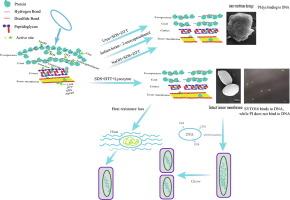剥皮产气荚膜梭菌孢子的构建与表征
IF 8
1区 农林科学
Q1 FOOD SCIENCE & TECHNOLOGY
引用次数: 0
摘要
细菌孢子复杂的多层结构对研究其内膜反应机制提出了挑战。然而,当有效地去除胞外壁、孢子外壁和孢子皮层,揭示孢子内膜的囊泡时,可以更直接地了解孢子内膜的变化。为了实现内膜的完全暴露,评估了四种方法去除细胞壁、孢子外壳和皮层的有效性。碱性蛋白变性剂(SDS-DTT)和溶菌酶处理维持了膜的完整性,平板计数为1.2 log±0.23 CFU/mL,而其他方法则造成膜损伤。形态学分析表明,孢子的长、短轴长度分别从1.77±0.17 μm减小到1.42±0.15 μm,从1.12±0.04 μm减小到0.83±0.08 μm。萌发效率从0.274提高到0.338,DPA释放量从1.46提高到1.59,两者的特性与原孢子非常接近(相似度为95%)。然而,耐热性下降了20%。联合处理保留了无皮层孢子的生物活性,表现出与原孢子相似的变化,证实了皮层主要增强了耐热性。去除皮层可以更直接地观察内膜动力学,并为研究孢子生物学提供了有价值的工具。该方法为今后孢子调控和内膜功能的研究奠定了基础。本文章由计算机程序翻译,如有差异,请以英文原文为准。

Construction and characterization of cortex-stripped Clostridium perfringens spores
The complex multilayered structure of bacterial spores poses a challenge to investigating the mechanisms governing inner membrane responses. However, when the extracellular wall, spore coat, and cortex are effectively removed, revealing the vesicles of the spore inner membrane, it would provide a more direct insight into the changes in the inner membrane. To achieve complete exposure of the intima, the effectiveness of four methods for removing the cell wall, spore coat, and cortex was evaluated. The treatment with alkaline protein denaturant (SDS-DTT) and lysozyme maintained membrane integrity, with 1.2 log ±0.23 CFU/mL plate counts, while other methods caused membrane damage. The morphological analysis revealed a reduction in the spore's long and short axis from 1.77 ± 0.17 μm to 1.42 ± 0.15 μm, and from 1.12 ± 0.04 μm to 0.83 ± 0.08 μm, respectively, while the inner membrane remained intact. Germination efficiency increased from 0.274 to 0.338, and DPA release increased from 1.46 to 1.59, with both properties closely resembling the original spores (>95 % similarity). However, heat resistance decreased by 20 %. The combined treatment preserved the biological activity of cortex-free spores, showing similar changes to those in the original spores, confirming that the cortex mainly enhances heat resistance. Removing the cortex allowed more direct observation of inner membrane dynamics and offers a valuable tool for studying spore biology. This approach provides a foundation for future research into spore regulation and inner membrane functions.
求助全文
通过发布文献求助,成功后即可免费获取论文全文。
去求助
来源期刊

Food Research International
工程技术-食品科技
CiteScore
12.50
自引率
7.40%
发文量
1183
审稿时长
79 days
期刊介绍:
Food Research International serves as a rapid dissemination platform for significant and impactful research in food science, technology, engineering, and nutrition. The journal focuses on publishing novel, high-quality, and high-impact review papers, original research papers, and letters to the editors across various disciplines in the science and technology of food. Additionally, it follows a policy of publishing special issues on topical and emergent subjects in food research or related areas. Selected, peer-reviewed papers from scientific meetings, workshops, and conferences on the science, technology, and engineering of foods are also featured in special issues.
 求助内容:
求助内容: 应助结果提醒方式:
应助结果提醒方式:


